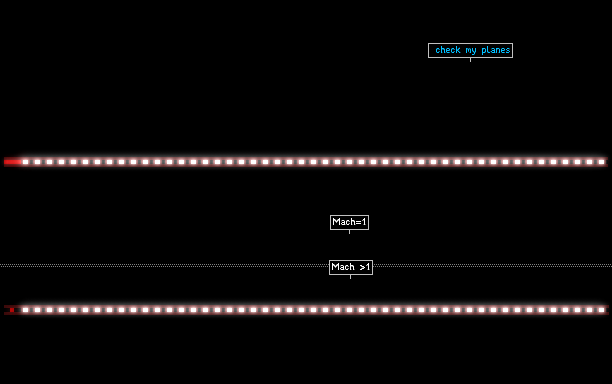sonic boom with protons by micaluky

No Description provided.
doppler
supersonic
sonicboom
soundbarrier
everyoneshutup
press6or0
3press
press2please
mach
cherenkov
Comments
-
Isidor10 25th Oct 2014
 This is what light can have mass and momentum despite having zero rest mass.
This is what light can have mass and momentum despite having zero rest mass. -
Isidor10 25th Oct 2014
 Most mathematicians will tell you this: when you multiply zero by infinity, you get a finite result.
Most mathematicians will tell you this: when you multiply zero by infinity, you get a finite result. -
Isidor10 25th Oct 2014
 Which, you'd think would be a divide-zero error. However, according to most mathematicians, 1/0 isn't just an error- as v--> 0, L--> infinity.
Which, you'd think would be a divide-zero error. However, according to most mathematicians, 1/0 isn't just an error- as v--> 0, L--> infinity. -
Isidor10 25th Oct 2014
 You see, when v=c, Lorentz Factor L=1/sqrt(1-c^2/c^2) =1/sqrt(1-1) =1/0
You see, when v=c, Lorentz Factor L=1/sqrt(1-c^2/c^2) =1/sqrt(1-1) =1/0 -
Isidor10 25th Oct 2014
 Light (photons) have been shown to have zero REST mass- meaning that if you weighed a photon using a set of scales travelling at c, you wouldn't measure any mass. However, something very weird happens to the m=(Lorentz factor)m0.
Light (photons) have been shown to have zero REST mass- meaning that if you weighed a photon using a set of scales travelling at c, you wouldn't measure any mass. However, something very weird happens to the m=(Lorentz factor)m0. -
Isidor10 25th Oct 2014
 However, in order for momentum to be conserved, mass must also increase with velocity according to the Lorentz factor. m=(m0)/sqrt(1-v^2/c^2)
However, in order for momentum to be conserved, mass must also increase with velocity according to the Lorentz factor. m=(m0)/sqrt(1-v^2/c^2) -
Isidor10 25th Oct 2014
 When a particle has velocity relative to an observer, it was shown through special relativity that time dilates (slows down) according to something called the Lorentz factor, 1/(sqrt(1-v^2/c^2))., where t=(t0)/sqrt(1-v^2/c^2) where t is measured time, t0 is proper time, v is velocity and c is the speed of light.
When a particle has velocity relative to an observer, it was shown through special relativity that time dilates (slows down) according to something called the Lorentz factor, 1/(sqrt(1-v^2/c^2))., where t=(t0)/sqrt(1-v^2/c^2) where t is measured time, t0 is proper time, v is velocity and c is the speed of light. -
Isidor10 25th Oct 2014
 sentinal-5, I'm sorry but I must beg to differ. The key problem in this discussion has been that people haven't differentiated between rest mass and mass- these are two different things.
sentinal-5, I'm sorry but I must beg to differ. The key problem in this discussion has been that people haven't differentiated between rest mass and mass- these are two different things. -
DemonLordElcium 24th Oct 2014
 Ferne, by definition, matter is anything that has volume AND mass. So yes, matter does neccasarily have to have mass
Ferne, by definition, matter is anything that has volume AND mass. So yes, matter does neccasarily have to have mass -
sentinal-5 24th Oct 2014
 if anyone tries to contradict that, surely you are saying you can prove Einstein wrong. good luck when the entire scientific community comes smashing through your door.
if anyone tries to contradict that, surely you are saying you can prove Einstein wrong. good luck when the entire scientific community comes smashing through your door.